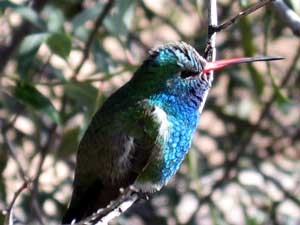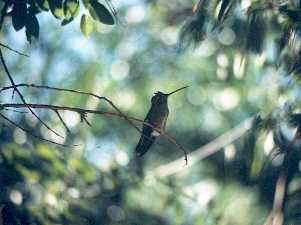

Hummingbirds
"Colibri" means hummingbird. Hummingbird is the common name for any of the more than 300 species of a family of small American birds, characterized by narrow wings whose rapid vibration produces a hum, by slender bill, and usually by brilliant plumage.

Photo: © Jan Söderkvist, Colibri Pro Development AB
Age
Hummingbirds can live up to 12 years, although many live only 3 to 5 years.
Bills
The slender bills of hummingbirds vary in size and amount of curvature according to the size and shape of the flowers favored by each species.
Breathe
A resting hummingbird takes 250 breaths per minute (4 times a second).
Color
Most hummingbirds are brightly colored and iridescent, commonly metallic green. The throat is often glittering red, blue, or emerald green, usually in males only. While most birds can attribute their color to pigmentation, the hummingbird's shimmering color is mainly structural in origin. Incident light is refracted by special cells within the top layers of certain feathers in a way similar to diffraction gratings or prisms. A consequence is that what appeared black can become blazing red when the hummingbird shifts its position just a little.
Flying
Hummingbirds are aeronautical artists. Their full control of the direction of thrust allows motion in any direction: up, down, forwards, to either side, and backwards. They can even do backward somersaults. Their hovering ability is believed to be due to that their wings function like a helicopter with two blades that rotate in opposite, frequently-reversing directions.
Food
An average hummingbird consumes half its weight in sugar each day. They feed on nectar and tiny insects found within flowers, and hover in front of the flower as they reach for their food with their long, extensible tongues. To move away from the flowers, hummingbirds must fly backwards, a maneuver no other bird is believed capable of.
Habitat
Hummingbirds occur in every part of the Americas, from the southern tip of South America to the Arctic Circle of Alaska. The greatest variety and number of species occur in South America.
Heart
A rate of 1260 beats per minute has been measured (20 times that of a human heart). In torpid hummingbirds, the heart rate can drop to 50-180 per minute. Their heart represents 2.4% of their body weight.
Migration
The longest migration route of any hummingbird is 5,000 km from their breeding range in Alaska to their winter grounds in Mexico. They can fly 800 km nonstop across the Gulf of Mexico which they accomplish by increasing their body weight by 50 percent before starting, storing energy as fat.

Photo: © Jan Söderkvist, Colibri Pro Development AB
Nests
Most hummingbirds build small cup-shaped nests covered with lichens, cobweb, and small pieces of bark, saddled on a branch. Two white eggs are laid, incubated only by the female. Hummingbirds have the smallest eggs of all birds.
Predators
Hummingbirds are incredibly quick and agile which makes it difficult for predators to catching them. They are fiercely territorial. When other birds come close, they usually chase or attack them. Hummingbirds are often even seen mercilessly harassing (and overcoming) large hawks as they vie for territory during migration.
Size
The hummingbird family contains the smallest of all birds; many species are less than 8 cm in overall length. The smallest species is the bee hummingbird in Cuba. Its males are slightly smaller than females, being about 5.5 cm long, and weighing only 1.95 gram. This is just a tiny fraction of the weight of a first-class letter.
Speed
In level flight some hummingbirds can attain maximum speeds of 40 km/h. During power dives, some species have been recorded at more than twice that speed.
Tidy
Hummingbirds often bathe by flying through sprinklers or spray from waterfalls.
Wings
The wing beat is so rapid that it produces a hum, which accounts for their common name. Some hummingbirds have been observed to flap their wings 80 times per second during regular flight and up to 200 times per second during display dives. Larger hummingbirds can have a wing beat rate of 10-15 per second. The wing muscles account for one quarter to one third of their total weight, which is noticeably larger when compared to members of other bird families.

Photo: © Jan Söderkvist, Colibri Pro Development AB
